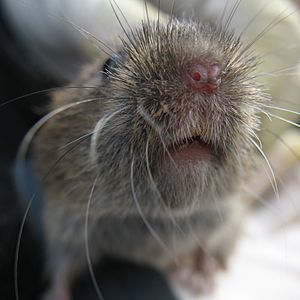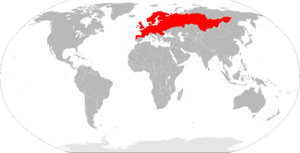Field vole facts for kids
The field vole or short-tailed vole (Microtus agrestis) is a small rodent, a type of vole. It's known for its short tail and usually grows to be about 10 centimeters (around 4 inches) long. You can find these little creatures across a huge area, from the coasts of the Atlantic Ocean all the way to Lake Baikal in Asia. They love to live in damp, grassy places like woodlands, marshes, or along river banks. The field vole is currently listed as a "least concern species," which means it's not in danger of disappearing.
Quick facts for kids Field vole |
|
|---|---|
 |
|
| Conservation status | |
| Scientific classification | |
| Genus: |
Microtus
|
| Species: |
agrestis
|
 |
|
| Field vole distribution | |
| Synonyms | |
|
List
Arvicola bailloni Selys‑Longshamps, 1841
Arvicola brittanicus Selys‑Longshamps, 1847 Arvicola hirta Bellamy, 1839 Arvicola intermedia Bonaparte, 1845 Arvicola levernedii Crespon, 1844 Arvicola neglectus Jenyns, 1841 Arvicola rozianus Bocage, 1865 Lemmus insularis Nilsson, 1844 Microtus arcturus Thomas, 1912 Microtus macgillivrayi Barrett‑Hamilton and Hinton,1913 Mus agrestis Linnaeus, 1761 Mus gregarius Linnaeus, 1766 |
|
Contents
What Field Voles Look Like
Field voles are small, furry animals. They have a stocky body, small ears that are often hidden by their fur, and a short tail. Their fur is usually brown or grayish-brown, helping them blend in with their grassy surroundings.
Where Field Voles Live
These voles are found across a wide range of habitats in Europe and Asia. They prefer places with lots of grass and moisture. This includes open grasslands, meadows, forests, and even marshy areas. They build networks of tunnels and runways through the dense vegetation, which they use to move around safely and find food.
What Field Voles Eat
Field voles are mostly herbivores, meaning they eat plants. Their diet mainly consists of grasses, herbs, and other green plants. They also eat seeds and roots. Sometimes, they might even nibble on bark or moss. They are very important in their ecosystem because they help control plant growth and are a food source for many other animals.
Life Cycle and Reproduction
Field voles can reproduce quite quickly. A female vole can have several litters (groups of babies) in a year, especially during warmer months. Each litter usually has about 4 to 6 young voles. The babies grow up fast and can start having their own babies when they are just a few weeks old. This fast reproduction helps their populations recover quickly, even if many are eaten by predators.
Predators and Threats
Many animals hunt field voles. They are a common meal for owls, hawks, foxes, weasels, and even snakes. Despite having many predators, field vole populations are generally stable. This is why they are considered a "least concern species" by conservation groups. Their biggest threats are usually habitat loss or changes in their environment.
Images for kids
See also
 In Spanish: Topillo agreste para niños
In Spanish: Topillo agreste para niños



